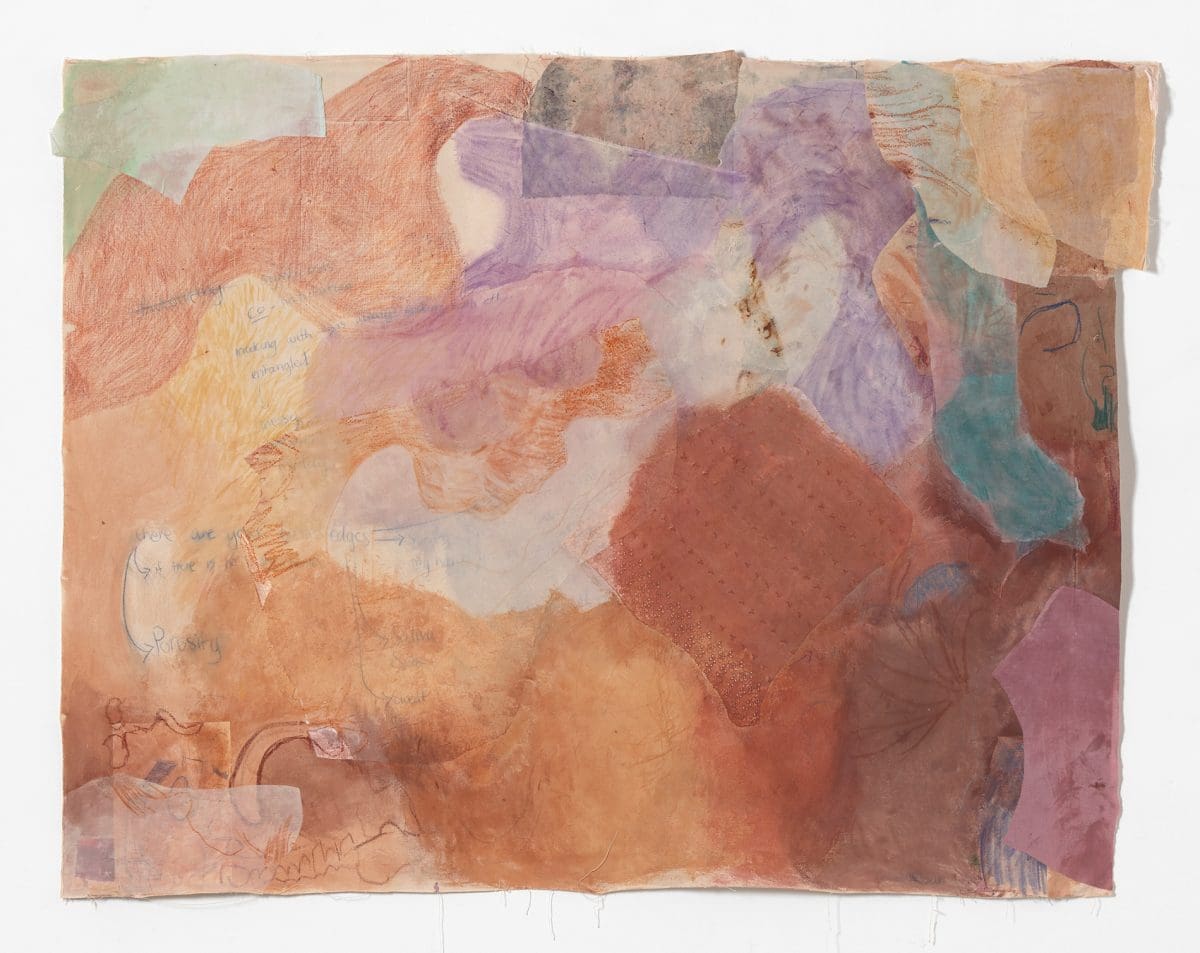
Place-driven Practice
Running for just two weeks across various locations in greater Walyalup, the Fremantle Biennale: Sanctuary, seeks to invite artists and audiences to engage with the built, natural and historic environment of the region.
Decay and renewal are key elements in the work of Jahnne Pasco-White. Blurring the boundaries between painting and installation, Pasco-White engages with a sensory blend of natural and artificial materials to create work imbued with rich colour and tactility. Densely layered, the Melbourne artist’s work also takes in the broader concerns of ecology and the human impact on the environment, the result being a vibrantly expressionist practice that illustrates lived experiences from a domestic and global perspective.
“In my work, layers of materials are tangled together through a process of cutting, pasting, smearing, soaking and washing to create varied ways of coming together,” she explains. Dyes lifted from avocado skins, spices and beech leaves are mixed with acrylic paint, oil stick and crayon to dictate the colours of her expansive canvases. Everyday flotsam is also part of the mix. “While I incorporate a lot of natural dyes from plants in my immediate environment, there is also waste—wrappers, drawings from my daughter, beyond repair clothing. My work is not setting out to be pure eco painting, but rather an acknowledgement of the contaminated nature of how we live in the world.”
Often working on huge canvas sheets designed to hang from the ceiling and stretch across the entire length of a gallery space, in order to accommodate their size and interconnectivity Pasco-White must work on the floor. At the mercy of her surrounds, Pasco-White lets each surface collect the dust and detritus of everyday life. Writing about the exhibition becoming with at Gertrude Glasshouse in 2019, Tara McDowell summed up Pasco-White’s paintings as “repositories of a much larger landscape—time capsules of a particular season, mood or day.” Looking at a series of paintings like messmates, 2019, one becomes privy to Pasco-White’s unique daily experiences, clearly evident in the small material remains of parenting a young child, slivers of used art materials and tracked-in fragments of the outside world embedded within their surfaces.
Viewing the human body as a malleable entity flowing with the same energy that passes through all things, Pasco-White keeps the parameters between herself and her work open. Explaining this concept further in the exhibition text for Bodily Feeling, her November 2021 solo show at STATION in Sydney, Pasco-White wrote, “Bodily feeling is that moment when I dive into the ocean and my skin melts and I am swimming like I am water in water. Bodily feeling reaches beyond the porous edges of my body; it is many bodies, it is tone, rhythm, composition.” Handpicked hibiscus, olive and rosemary all form the dyes that stain the delicately stacked, puzzle-like surfaces in Bodily Feeling. “Bodily feeling is to imagine one can too be consumable, compostable, evaporating like steam sopping into someone else’s pores.”

Choosing to work on several paintings at once, Pasco-White goes through a process of “feeding” each work, constantly adding and working new materials into her surfaces. “The colours, marks and dyes stretch over many canvases as each work progresses alongside and informs the other,” she says. Once complete and no longer in use, older paintings are cut up and fed into another painting— it’s an ongoing cycle of renewal. Most recently, pieces of earlier paintings appeared in Making Kin, 2020, Pasco-White’s three-panelled work currently showing in the group exhibition Material Reverie at the Town Hall Gallery in Boroondara. Contained within this work were pigments made from sunflowers, carrot and black bean. This is all brought together in a wide expanse of colour layered with contrasting textures and gestural marks, disparate yet strangely harmonious when placed together.
Currently working towards a Master of Fine Art at Monash University, Pasco-White’s research reflects her ongoing interest in fluid substances and porous materials. Titled ‘An Embodied Watery Methodology of Painting’, her MFA project draws heavily on gender and cultural theorist Astrida Neimanis’s concepts of contemporary hydro-feminism. Further influenced by the writing of environmental and feminist scholars like Stephanie Erev and Donna Haraway, Pasco-White hopes to continue creatively exploring our increasingly troubled relationship with the world around us. “My work is about how we are implicated indirectly and directly in things we may not necessarily morally agree with. Through the fluidity of the plant dyes, the viscous rice glue and painterly washes—all explicate the porous flows connecting my body to the painting, and the materials with the world.”
Material Reverie
Group exhibition
Town Hall Gallery
20 January—9 April
Wall Drawings (presented as part of MPRG’s Spring Festival of Drawing 2021)
Group exhibition
Mornington Peninsula Regional Gallery
12 November 2021—13 March
This article was originally published in the January/February 2022 print edition of Art Guide Australia.